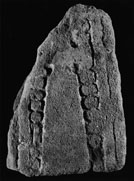Select a site alphabetically from the choices shown in the box below. Alternatively, browse sculptural examples using the Forward/Back buttons.
Chapters for this volume, along with copies of original in-text images, are available here.
Object type: Part of grave-marker [1]
Measurements: H. 33 cm (13 in); W. 22.7 cm (8.9 in); D. 10.7 cm (4.2 in)
Stone type: Fine-grained, dolomitic, white to very pale brown (10YR 8/2–8/3) limestone, with small cavities; Lower Magnesian Limestone, Upper Permian; reused Roman ashlar, originally from Tadcaster area (see Fig. 5)
Plate numbers in printed volume: 333-336
Corpus volume reference: Vol 3 p. 103
(There may be more views or larger images available for this item. Click on the thumbnail image to view.)
The stone tapers.
A (broad): A double flat edge moulding flanks a plain, long stemmed cross in low relief. The arm-type is uncertain: probably type B11. The tapering stem is flanked by a row of bold pellets at each side.
B and D (narrow): A flat edge moulding flanks a vertical run of broad chevrons, partly broken away on face D.
C (broad): The edge moulding is flat. Within is a plain rectangular moulding, also flat, framing a vertical run of broad chevrons.
Small grave-markers are rare in York itself, unless this is an end stone from a composite group including a grave-cover. It is very like one at Escomb (no. 7) in co. Durham (Cramp 1984, I, 79, II, pl. 55, 270–2). The cross type is a common tenth-century shape.



